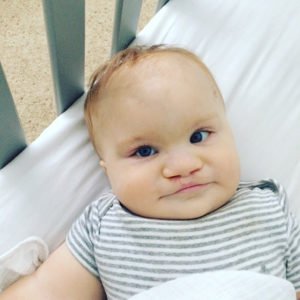One in 700 babies are born each year with a cleft lip and palate, which means a baby’s lip and mouth do not form properly during pregnancy, creating a “cleft.”
A cleft lip happens if the tissue that makes up the lip doesn’t completely join before birth. A cleft palate occurs if the tissue that makes up the roof of the baby’s mouth doesn’t connect completely. The conditions can occur separately or together. Both conditions usually require surgery to fix; some cleft palates require multiple surgeries.
While these may be common birth defects, if your baby is born with a cleft lip and palate, you may feel overwhelmed and have many questions or concerns about caring for your baby.
We talked to Heather Jones, whose son, Camden, was born with a cleft lip and palate, and Jeyhan Wood, MD, director of craniofacial and pediatric plastic surgery at UNC Medical Center, to learn their top three tips for caring for a baby with a cleft lip and palate.
1. Find a team of experts.

Dr. Wood says the ideal care team for a baby born with a cleft lip and palate consists of experts in plastic surgery, otolaryngology, oral surgery, pediatric dentistry, speech therapy, feeding therapy, nutrition and developmental psychology.
“Finding a team of experts to meet your needs and that you mesh with is of utmost importance,” Jones says.
This team approach to care helps to ensure your baby maintains a healthy weight from birth, because feeding difficulties can be common in babies born with a cleft lip and palate.
“Feeding is our biggest priority after they’re born,” Dr. Wood says. “Even if you want to breastfeed, you can’t because the baby can’t form suction. It’s like sipping in a straw with a hole in it. It causes a lot of frustration for mom and the baby, and they lose more weight than necessary.”
If you still want your baby to have breast milk, you can pump it and provide it to your baby with a specialized feeder. The feeding therapists on your care team can help you customize it to meet your baby’s needs.
“They’ll give you tips on how to hold the baby, how long you should be trying to feed at a time, and they will look at how efficiently they’re feeding,” Dr. Wood says.
2. Prepare to have your baby use a sippy cup before age 1.
Your baby will probably have surgery around 3 or 4 months to repair the cleft lip. The procedure will correct the cleft and usually leaves minimal scarring.
Then around 10 months, he or she will have surgery on the cleft palate. “That’s giving the baby a roof of their mouth,” Jones says.
Dr. Wood says the surgery is performed at this age because it’s before the baby starts to talk or “meaningful speech gets started.”
After this surgery, your baby cannot drink from a bottle because the nipple from the bottle can irritate the surgical site. “We are trying to minimize any potential trauma to the incision on the roof of the mouth,” Dr. Wood says.
Babies typically need to transition to a free-flowing sippy cup at this time, which is several months earlier than usual. Jones says you may need to try several types to find the sippy cup that works best for your baby.
Dr. Wood says that if your baby cannot do this, don’t fret. “We can do other things, at least for the first couple days, like syringe feeding, and then I let them go back to the bottle.”
3. Learn how to swaddle.
Babies love to put their hands in their mouths, which is adorable and normal. However, they cannot do this after surgery because they can harm the surgical site or even cause an infection. So babies have to wear a padded restraint device called a “no-no” to prevent them from bending at the elbow for about two weeks until the surgical scar heals.
“A lot of the kids become little Houdinis and get out of it, so we ended up just swaddling him, which was much easier than the no-no,” Jones says.
Dr. Wood says if you’re holding your baby and can monitor his or her hands, you don’t have to swaddle or use the no-no.
“If they’re engaged during the day, they don’t necessarily need to be wearing it. It’s mainly for sleeping at night in their crib,” Dr. Wood says. “We just don’t want them to undo an incision or pull out the stitches.”
If you have questions about your child’s cleft lip and palate, talk to your doctor about what to expect and don’t be afraid to ask questions.

